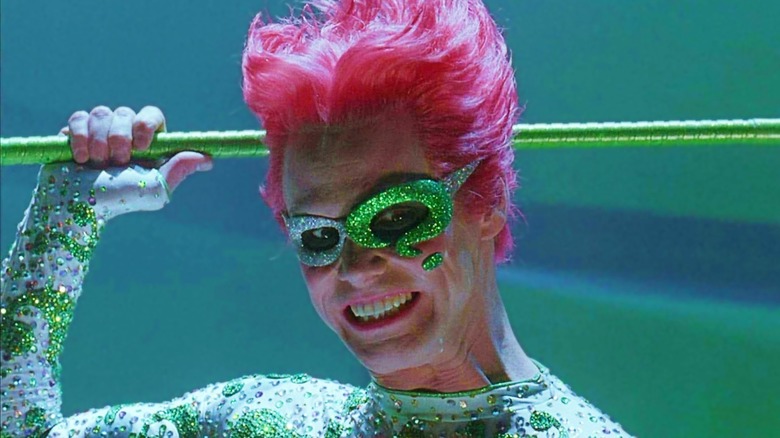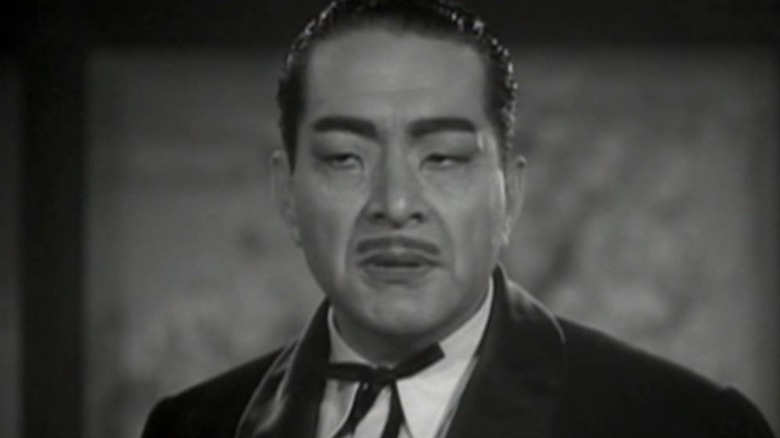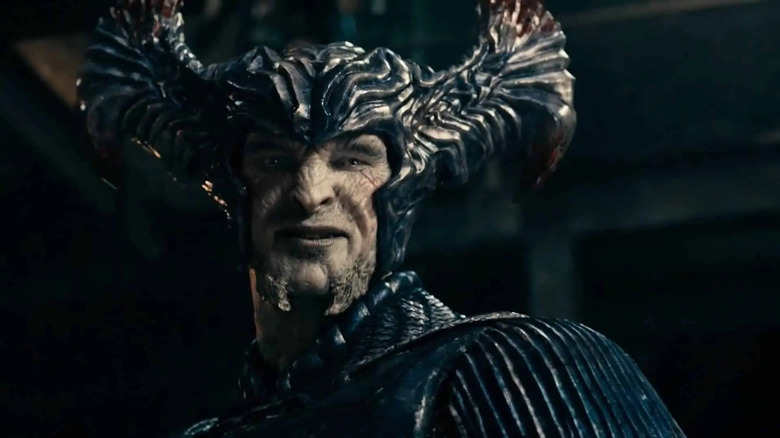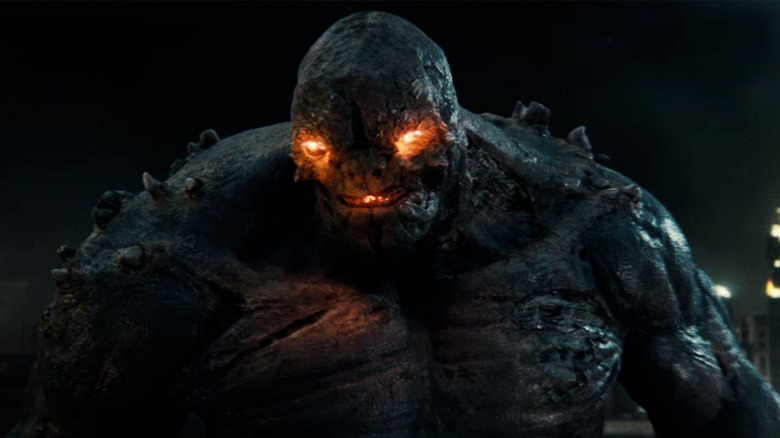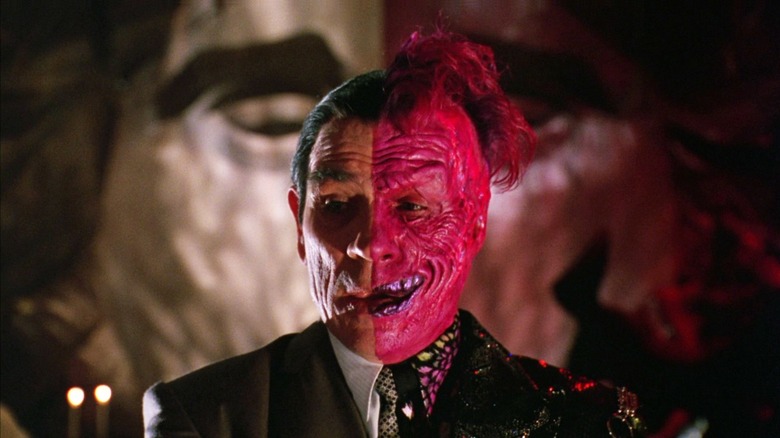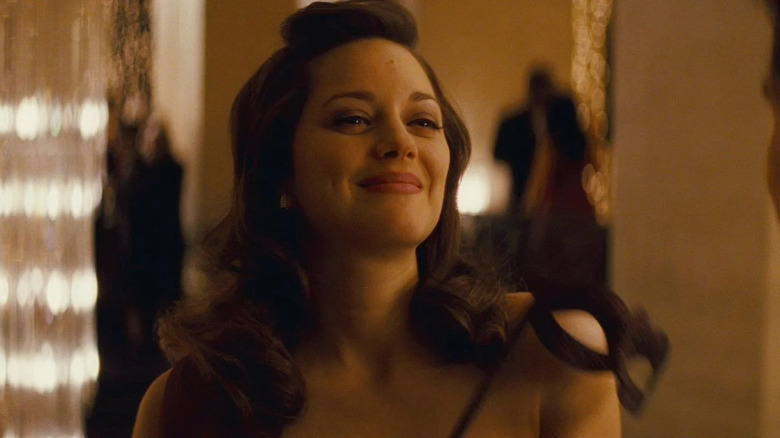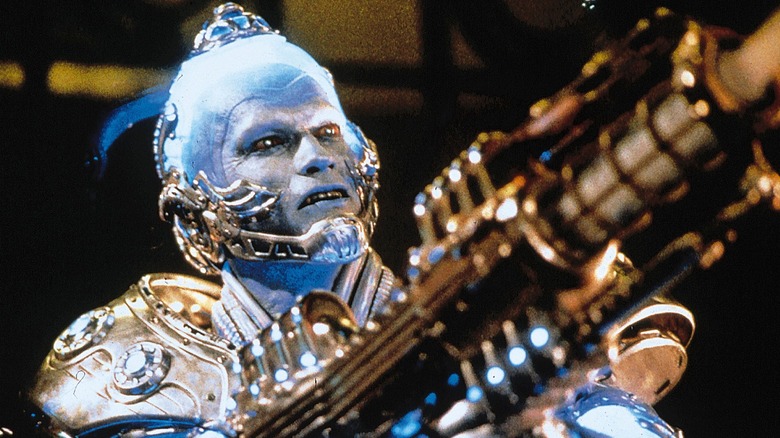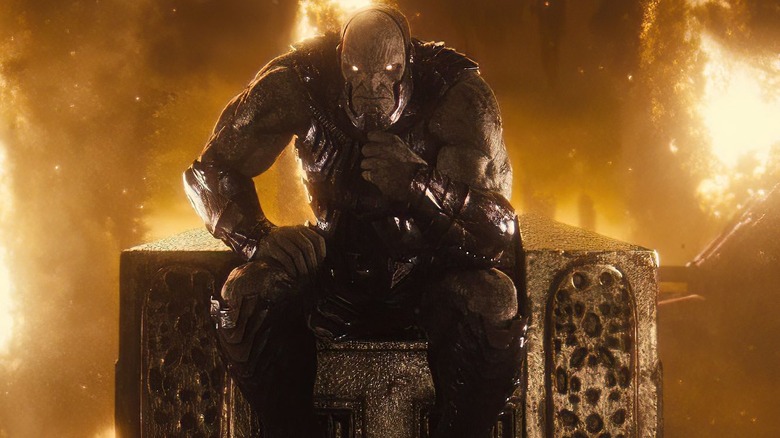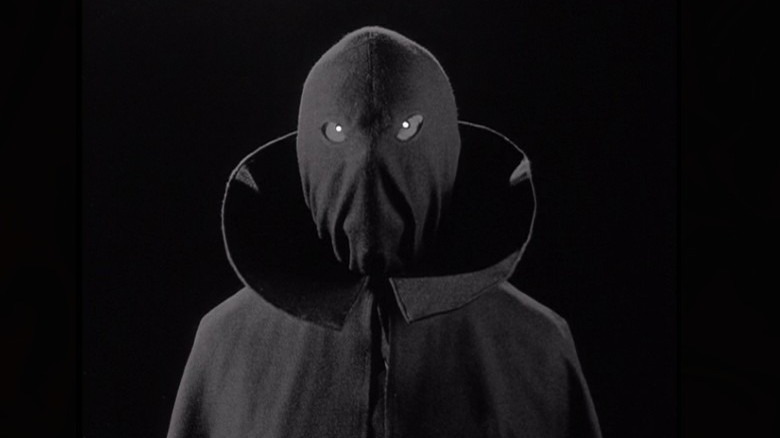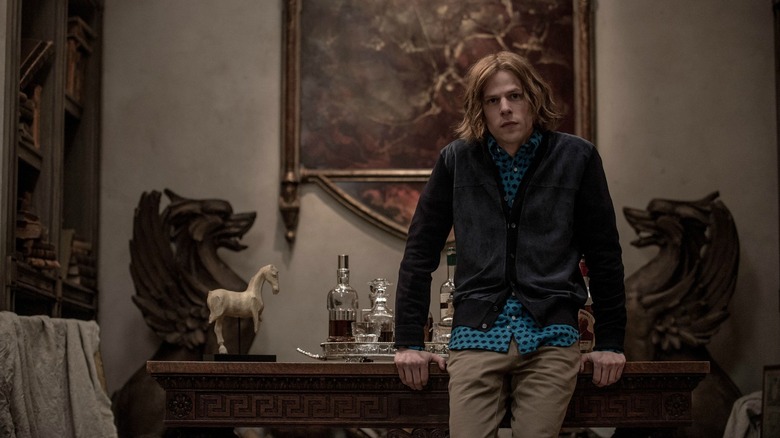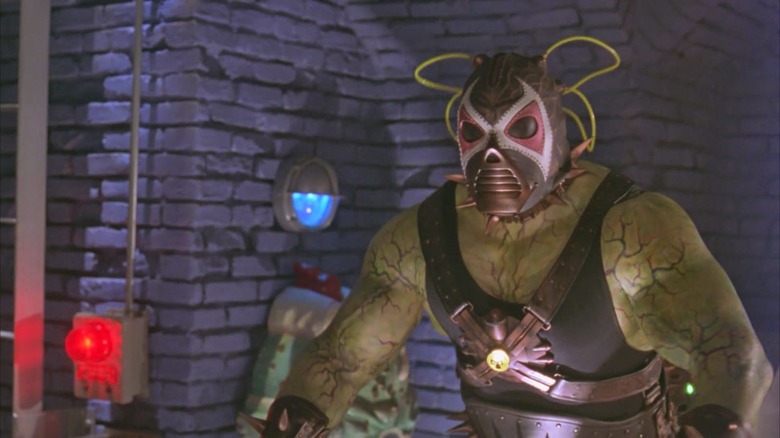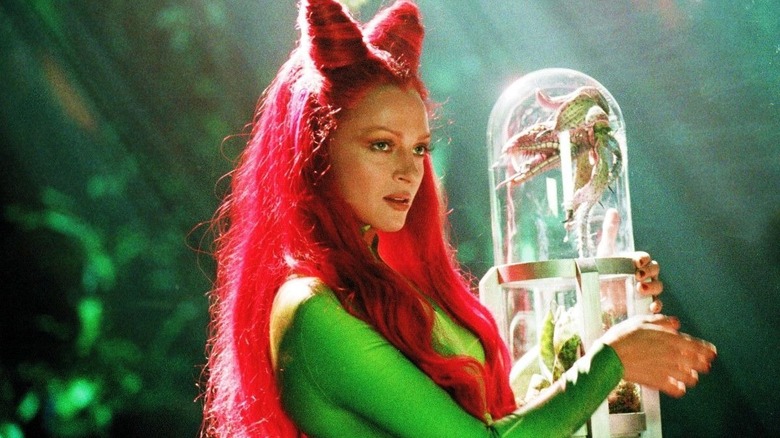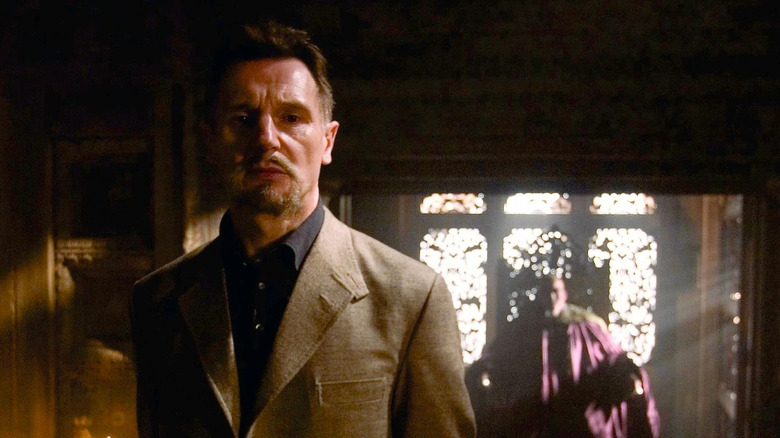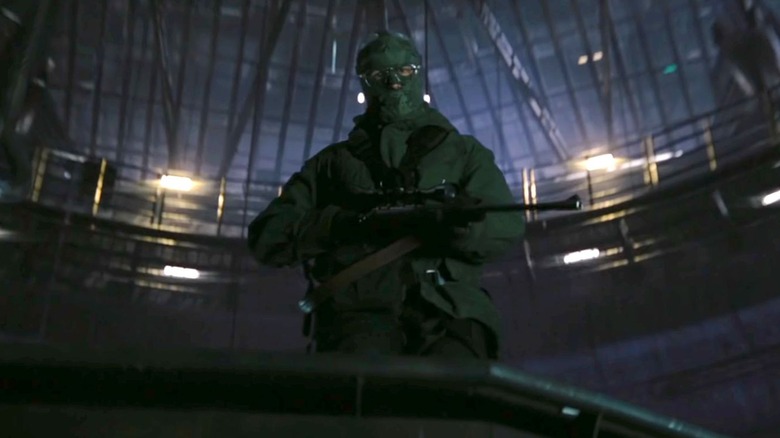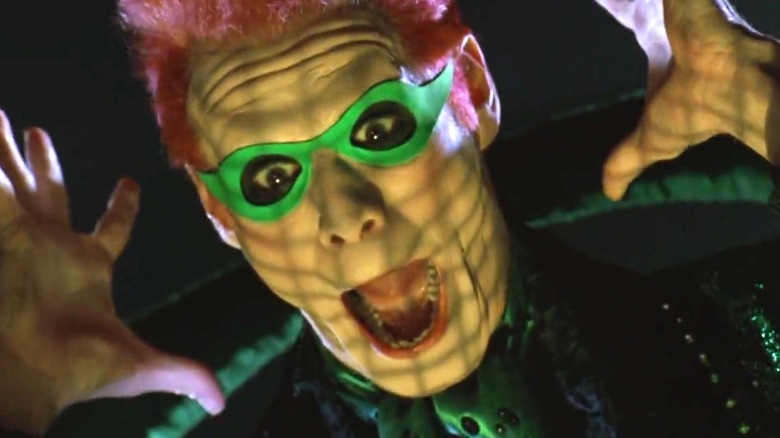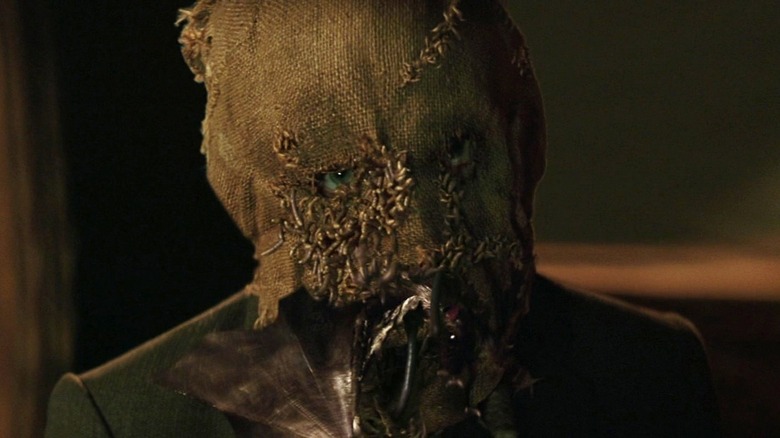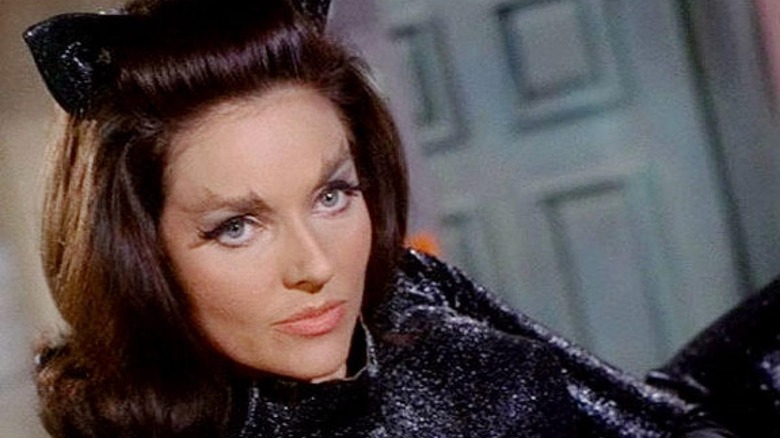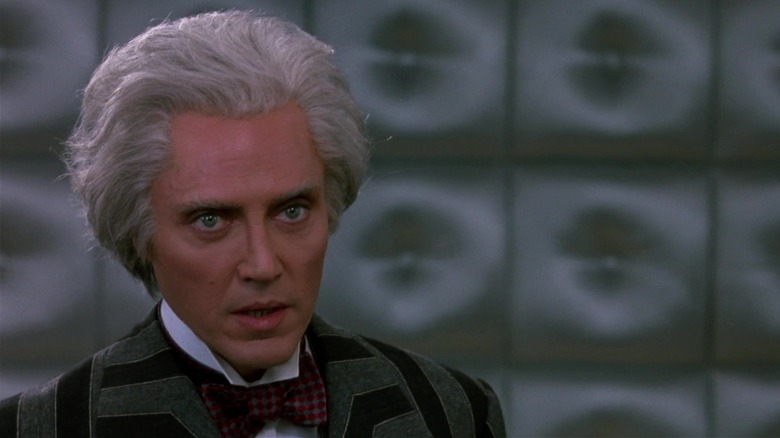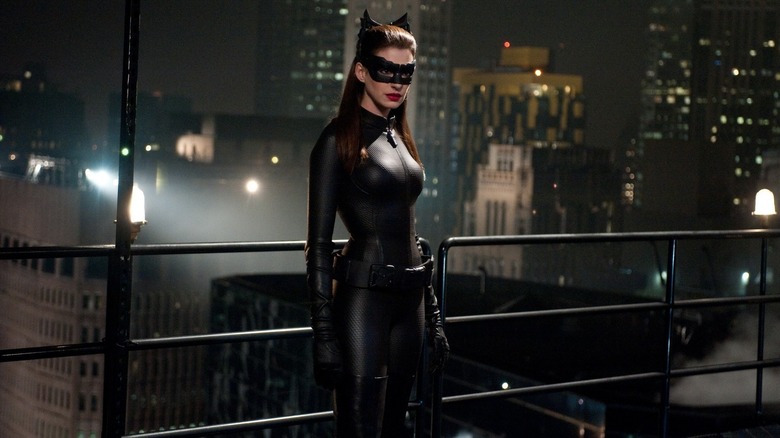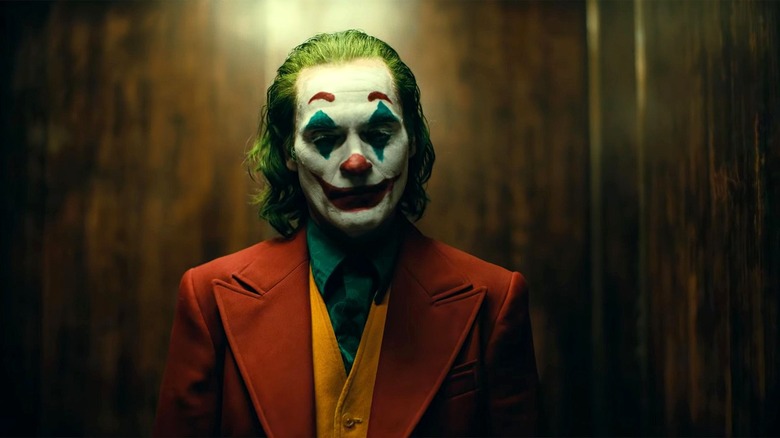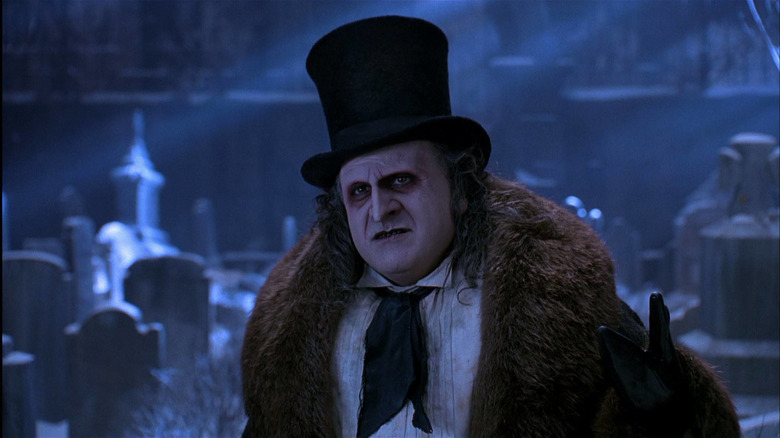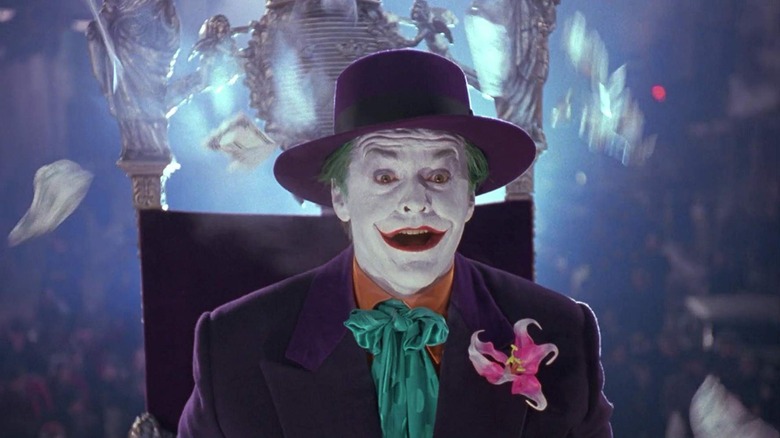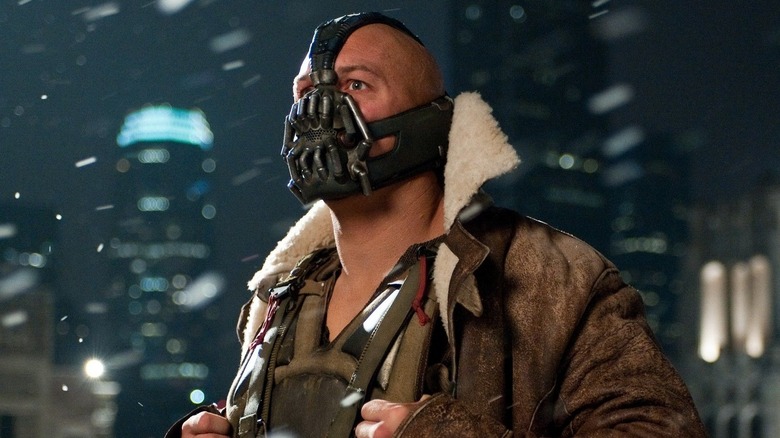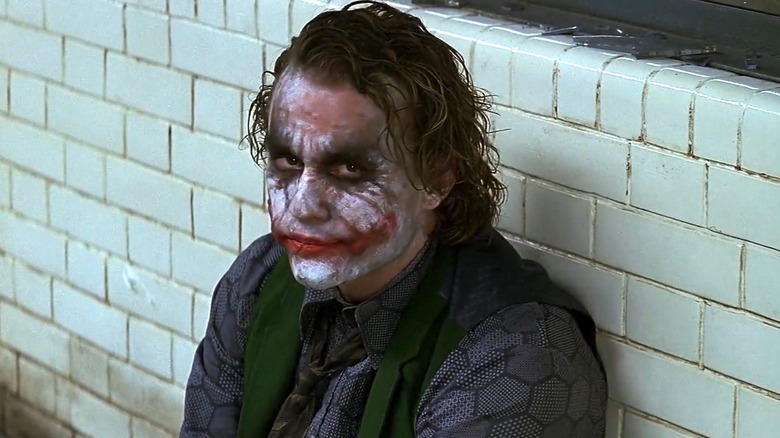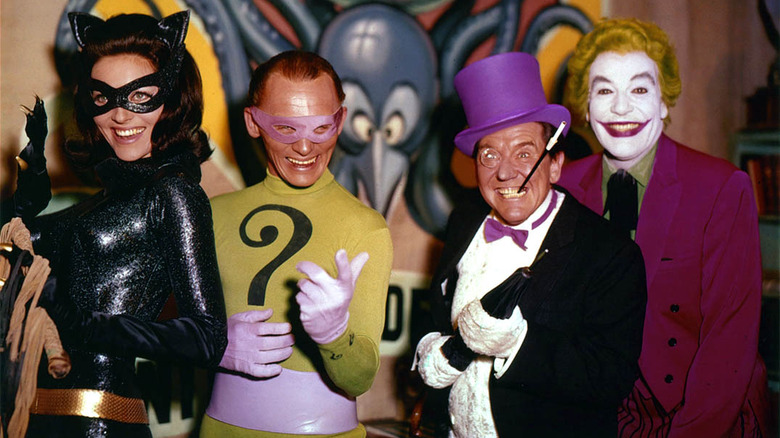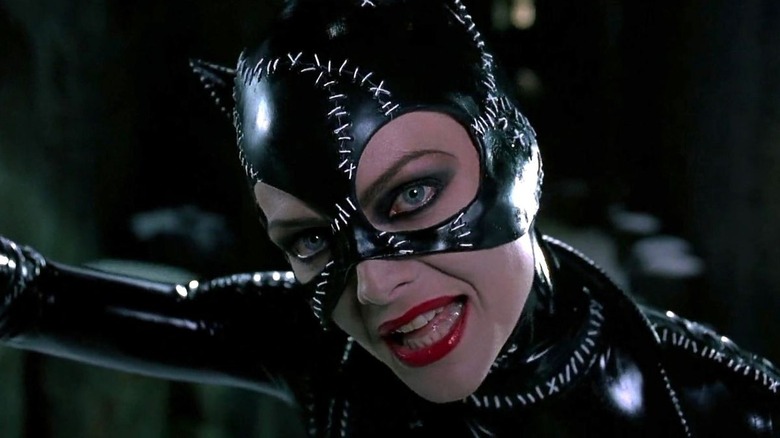The Best Live-Action Batman Villains Ranked
While Batman has been an institution in popular culture since the 1930s, it wasn't until the 1960s that the character gained a good deal of traction in the popular consciousness, thanks primarily to the William Dozier-produced CBS TV show. And while Adam West and Burt Ward were the stars of the show, one of the more attractive gimmicks of "Batman" was the regular rotating retinue of celebrity cameos and guest villains. In addition to mainstays like Cesar Romero, Frank Gorshin, and Academy Award nominee Burgess Meredith, "Batman" also featured the likes of Milton Berle, Shelley Winters, Lesley Gore, Joan Collins, Liberace (as twin brothers!), Anne Baxter, John Astin and Carolyn Jones, Vincent Price, and three different Mr. Freezes (George Sanders, Otto Preminger, and Eli Wallach).
The gimmick of casting recognizable faces as Batman villains is a tradition that's upheld to this day with the excellent Paul Dano as the Riddler and Colin Ferrell as the Penguin in "The Batman." And, because it is our wont, we shall heretofore go about ranking all 28 of the Batman villains as they have appeared in live-action feature films. Apologies to fans of "Batman: Mask of the Phantasm."
NB: Although the character of Catwoman is one of the better-known Batman villains, Zoë Kravitz' rendition of Catwoman will not be appearing on this list, as her character in "The Batman" is an ally rather than a villain.
28. Dr. Daka
Batman's first appearance on the big screen was in a 1943 serial, wherein the Dark Knight (Lewis Wilson) was a government agent facing off against a conspiracy of Japanese spies who sought to sabotage Gotham City's supply chain. The serial features a lot of racist stereotypes — a regrettably common feature of American entertainment following the bombing of Pearl Harbor in 1941 — not least of which was the central villain of the piece, Dr. Tito Daka, played by the Irish-American, New York-born actor J. Carroll Naish. One can forgive Dr. Daka his cliched, villainous, world-domination speeches, as he was a product of the 1940s and demonstrative supervillain language was not yet de rigueur. A modern audience will have a much, much more difficult time forgiving the racist imagery.
27. Steppenwolf (2017 version)
A common criticism of Marvel Cinematic Universe movies is that they feature comparatively nondescript villains with pretty broad supervillain motivations. That criticism would be more appropriately saved for the villain of the theatrical cut of "Justice League," Steppenwolf, a powerful space alien who wants to take over the world using a trio of powerful boxes called (snicker) Mother Boxes. Although voiced by stalwart Irish actor and Academy Award nominee Ciarán Hinds, Steppenwolf has no personality whatsoever, a dull design, and a disturbingly unconvincing CGI face that was not permitted to be entirely expressive. Steppenwolf is the naked paper doll onto which supervillain clothes are yet to be hung.
26. Doomsday
Appearing only in the climax of the turgid and ponderous "Batman v. Superman: Dawn of Justice," Doomsday was a giant Hulk-like monster with bone spurs and a laser face. It was created by placing General Zod's body in the Genesis Chamber of his ship, and mixing in a little Lex Luthor DNA. One would think a more interesting monster would be created from such a combination, but instead audiences were "treated" to a monster that, at the end of the day, could have looked like literally anything. Heck, it could have been the Hulk, and the film would not have changed one iota. Batman, Superman, and Wonder Woman spend a significant portion of the movie punching this monster, and it's incredibly boring to witness.
25. Two-Face (1995 version)
Tommy Lee Jones is fascinating actor and a talented director to boot (watch his films "The Three Burials of Melquiades Estrada" or "The Homesman" sometime), but he took a great leap away from his good senses to play Harvey "Two-Face" Dent in Joel Schumacher's "Batman Forever." Despite a few speeches about flipping coins and relying on fate, Jones played Two-Face a little more than a drunken, cackling weirdo with no stated motivations beyond general supervillainy. He robs banks and holds up Gotham's elite at gunpoint, all to merely become richer, I suppose. Eventually he becomes the Riddler's hired goon. At the very least, he was involved in a polycule with Drew Barrymore and Debi Mazar.
24. Talia Al Ghul
Marion Cotillard played Miranda Tate in "The Dark Knight Rises" as a grounded, human character, meant to offer Bruce Wayne access back into "the real world," as it were, and served as a counterbalance to the chaos and villainy that Batman had encountered as a costumed vigilante. Mildly upsetting, then, that Miranda Tate turned out to be — snore — the secret mastermind behind that same film's Bane (Tom Hardy). More upsetting still, her motivation was merely that she was related to the villain Ra's Al Ghul from two films previous. There is no more tiresome plot twist than "we were related all along" (an Oliver twist, if you will), and Talia's connection to previous movies reeked of uncreativity.
Note: I know Ra's and Talia were established in the comics prior to "The Dark Knight Rises." I know Talia has a long and complex history and is beloved by many. My complaint is that, for this film in particular, Miranda Tate needn't have been redubbed Talia. Talia could have been left out altogether. If your central villain can be deleted from the film without adversely affecting the story, you have a problem.
23. Mr. Freeze
While readers of Batman comics have assured me that Mr. Freeze has become a character of deep sadness and pathos over the years, none of that pathos can be seen in the "Batman & Robin" version of the freeze-ray-wielding supervillain. As played by Arnold Schwarzenegger, Mr. Freeze is a clinking, clanking, clattering collection of caliginous junk who seeks to resurrect a comatose wife, but who spends just as much time in his goofy lair making insufferable jokes about cold weather and forcing his minions to sing the Snow Miser's song from "The Year Without Santa Claus." The Snow Miser would have made for a better villain.
22. and 21. Steppenwolf and Darkseid (2021 versions)
In the notorious Zack Snyder cut of "Justice League," an entirely new character had been added to the story in the form of Darkseid (Ray Porter), the true mastermind behind Steppenwolf's plan to acquire Mother Boxes. Darkseid sought to take over the world because he was an evil god who wanted dominance and was more powerful than the Earthlings he sought to dominate, and while there is a philosophical purity to that, it doesn't make for a terribly dynamic character in a superhero film, no matter how long it is. More interesting is Snyder's altered version of Steppenwolf, who in this version is Darkseid's uncle, and who falls to pathetic toadying when talking to his nephew boss. Steppenwolf is still not terribly interesting, but he's more interesting in the longer version of "Justice League" than in the theatrical cut.
20. The Wizard
The Wizard (Leonard Penn) was a hooded villain who had a variety of powers, most notably a remote control that could control cars — a novelty in 1949, when the "Batman and Robin" serial played in theaters. Unlike Dr. Daka from the previous serial, released six years before, the Wizard was actually threatening, and even a little bit scary. Using technology, the Wizard could hypnotize victims as well, and I'm a sucker for a good "looook into my eeeeeyes" bit. Given that Batman is a creature of the night who uses technology to hunt down adversaries, a good balance would indeed be a supervillain who does the same.
19. Lex Luthor
In "Batman v. Superman: Dawn of Justice," Lex Luthor (Jesse Eisneberg) is reimagined as the tech-bro son of Lex Luthor who has adopted an annoying Randian philosophy of human exceptionalism. While someone who clearly reads too much Ayn Rand makes for an interesting villain in concept — especially as director Zack Snyder likes to openly play with objectivist notions of power and superiority throughout his movies — the cinematic version of Lex Luthor is muddled and scatterbrained. It's nearly impossible to suss out his motivations for villainy, and definitely impossible to figure out the mechanics of his scheme. Eisenberg is fine in the role, but he was failed by a bad script.
18. Bane (1997 version)
Readers of Batman comics were mighty upset with the portrayal of Bane (Robert Swenson) in "Batman & Robin," as the on-screen version was a far cry from the source material. In "Batman & Robin," Bane is a former criminal who is injected with venomous super drugs to inflate his body, but deteriorate his mind, turning him into a hulking, green, luchador thug. Not exactly a rich, nuanced character, but I cannot help but have at least a little fun with a hulking, green, luchador thug. Indeed, a fellow critic once suggested that "Batman & Robin" becomes better when viewed as a luchador film — and lo, there's even a luchador in it.
17. Poison Ivy
Uma Thurman should get all the credit in the world for being one of the only actors in "Batman & Robin" to understand the assignment. Dressed in a series of unbelievably ridiculous costumes, Thurman plays Poison Ivy with two mighty fistfuls of camp, with Mae West in one fist and Divine in the other. Oh, the dialogue is stupidity of the highest order, and much hay has been made of the fact that Poison Ivy's plan to fill the world with plants after Mr. Freeze has frozen it seems to be foolish (even though there are plants that can grow in cold climates). But at least Thurman had more fun than the audience ever did.
16. Ra's Al Ghul
Christopher Nolan's "Batman Begins" was certainly not the first superhero origin movie, but it was the first to take a "ground-up" approach to Batman, asking what sort of practical real-world events would need to happen in order for a Batman to happen. Tim Burton adjusted the world to fit Batman. Nolan adjusted Batman to fit the world. It turns out being a rich guy on a worldwide retreat who falls in with a group of justice-minded ninjas would be an important part of becoming Batman, and a mentor set on fighting evil will help immensely ... Until that mentor decides that city life is the evil that needs to be fought. Ra's Al Ghul was well-spoken, and offered Batman an intriguing (if mad) alternate viewpoint to justice.
15. The Riddler (2022 version)
In "The Batman," The Riddler was reimagined as a combination of the Zodiac Killer and John Doe from David Fincher's "Se7en." Played by Paul Dano, this version of the Riddler is a sloppy but fascinating hodgepodge of a serial killer, the Joker, and an incel QAnon believer. "The Batman" is overlong, which meant that The Riddler was actually given far too much screentime, leaving his mysterious threat a little less-than-threatening. But transforming the Riddler into the Zodiac Killer is most certainly an interesting idea.
14. The Riddler (1995 version)
It's hard to explain the force of nature that was Jim Carrey if you weren't there in the mid-1990s for his rapid ascendency. Carrey was in three films in 1994 ("Ace Ventura: Pet Detective," "The Mask," and "Dumb and Dumber") pretty much assuring at least a decade of superstardom. Seeing Carrey sporting a pink flattop and wearing the bright green question mark outfit was a thrill unto itself, and Carrey brought more manic energy to the role than any actor did to any Batman villain before or since. He's hilarious, and his Riddler is weird and kooky in all the right ways.
13. The Scarecrow
The best Batman villains serve as balances or counterpoints to the hero himself, and Scarecrow, as depicted in "Batman Begins," certainly fits the bill. Batman, after all, uses his costume to strike fear into the hearts of criminals. The Scarecrow uses a creepy burlap mask as a whiff of fear-inducing gas to control his patients. Oh yes, and he's a shrink, played by Cillian Murphy. Murphy, who can play villains and heavies with the best of them, brings a calm menace to the Scarecrow, making him recognizable in an everyday sort of way. He is a manipulator. A controller. That's kind of terrifying.
12. Catwoman (1966 version)
When Julie Newmar wasn't available to make a Batman feature film in between seasons 1 and 2 of the popular TV series, the studio hired Lee Meriwether to step in, and she did so capably. Newmar was the funnier of the two versions, but Meriwether actually acted the part with a touch more richness. Although she purred and meowed with the best of them, she also served as "Batman's" most notorious villain in the 1966 film, seducing Bruce Wayne in the guise of a Russian journalist named Kitayna Ireyna Tatanya Kerenska Alisoff, or KITKA for short. Meriwether fell right into the wacky world of Batman, and lived there comfortably alongside the kooky likes of Frank Gorshin.
11. Max Schreck
"Bruce. Shame on you. No such thing." Christopher Walken's wicked business tycoon fit weirdly well into the angular and bizarre world of Tim Burton's "Batman Returns," transforming what could have been a dull yuppie into a character that reads as vaguely supernatural. Max Schreck is just as menacing as any supervillain, and Walken's sideways-approach-to-language made him imminently watchable. In script form, you can see Schreck (named after the actor who played the vampire in "Nosferatu") as a mirror to Bruce Wayne; an evil businessman to counter Bruce's good businessman. In practice, he became far more odd, making him, to my eye, far better.
10. Catwoman (2012 version)
The 2012 version of Catwoman, as she appeared in "The Dark Knight Rises," was an agent of chaos, operating independently of the central plot of the film. However, since she and Bane, the film's central villain, both targeted the wealthy, she also served as an important political symbol as well. She lived, with a wicked smirk on her face, to take money from the rich. She wasn't so much Batman's enemy as Bruce Wayne's. Anne Hathaway didn't use the word "Catwoman" in the film, and her catsuit only had little cat ears because of a pair of goggles she wore, feeding into director Christopher Nolan's vision of Batman as a practical matter. She's still a pretty fantastical character, but this was a fine approach.
9. The Joker (2019 version)
Borrowing Christopher Nolan's what-would-need-to-happen-in-the-real-world-to-create-a-comic-book-character approach to a Batman character, director Todd Phillips asked what kind of person would become a Joker. "Joker" is not a great film; its grimy, Scorsese-like atmosphere is but window dressing for a rather simple script that lacks a great deal of focus. But Joaquin Phoenix's performance alone (which won him an Academy Award) brings us deep into a suffering man's psyche, showing how disconnected from the world he is. The costume by Mark Bridges is striking and unique. And yes, Bruce Wayne is also in the film, as a boy who very well may be the Joker's half-brother. That last part was kinda silly.
8. The Penguin (1992 version)
Danny DeVito's version of the Penguin as seen in Tim Burton's "Batman Returns" is a pathetic figure, selling a sad-sack tale of being abandoned as a child (his parents threw him off a bridge) to gain traction in a mayoral race. He was also a truly disgusting villain who was constantly spitting up black ink and ramming raw fish into his fanged maw. There was nothing not repellent about this version of the Penguin, and DeVito's performance is both disgusting and exhilarating. "You're just jealous," he shrieks to Batman in that film's climax, "because I'm a genuine freak, and you have to wear a mask!" Like all Burton characters, he is an outsider, so you kind of admire this Penguin, despite how gross he is.
7. The Joker (1989 version)
Jack Nicholson was top billed in Tim Burton's "Batman" in 1989, and it's easy to see why. In comparison to the laconic Batman played by Michael Keaton, Nicholson brought all the energy. This Joker was envisioned as older than the version seen in the comics; an established "made man" who fell into a vat of skin-bleaching chemicals, went mad, and poisoned consumer products with a chemical that kills you and mutates your face into a grin. Jack Nicholson is wholly devoted to the madness and the violence, and, because he had a crime career behind him, seemed to have more power to scoop into that chaos.
6. Bane (2012 version)
Although difficult to understand through his facial appliance, this version of Bane from "The Dark Knight Rises" was a glorious political comment for the time. "Rises" was made during the Occupy Wall Street protests demanding financial justice, and Bane stepped into the Batman universe with a similar message for Gotham City's wealthy. Bane, in destroying the Bat Cave, and hobbling Bruce Wayne, pointed out to him — and to audiences — that becoming a Batman was not, perhaps, the best use of your money. Tom Hardy, even with half of his face covered, managed to convey authority and menace. A striking Batman villain for a more self-aware age.
5. The Joker (2008 version)
Heath Ledger won an posthumous Academy Award for playing the Joker as a punk rock anarchist who committed crimes not to acquire money or power (indeed, he sets money on fire), but to sow chaos merely for the sake of sowing chaos. Ledger is legitimately terrifying in the role, presenting a Batman villain as a slasher monster. In 2008's "The Dark Knight," Batman — essentially a cop — is presented as representing law and order, making this Joker his mirror image, representing anarchy. The character become extra powerful when audiences slowly come to realize we don't know where he came from. Some people, as Alfred says, just want to watch the world burn.
4. 3. and 2. The Joker, The Riddler, and The Penguin
The best Batman film to date remains Leslie Martinson's comedy classic from 1966. One of the silliest, brightest, and most frankly absurd movies ever made, "Batman" is a sugar rush of a film, leaving the hazy residue of long-forgotten childhood memories manifested as weird question-mark people. In the film, the Joker, the Riddler, the Penguin, and Catwoman team up to kidnap the UN, dehydrate the world leaders into powder, and hold them hostage. Cesar Romero, classy AF, brings a cackling glee to the mix, Burgess Meredith as the Penguin brings in the brains, and Frank Gorshin brings the chaotic Jim Carrey energy to The Riddler from when Jim Carrey was only 4 years old. Catwoman was a more balanced character and made sure "Batman" worked as an actual movie, giving her her own slot above.
"Batman" was a hit, and has lost none of its vital energy since 1966. What a delight. A film for fun-lovers everywhere.
1. Catwoman (1992 version)
What Tim Burton's "Batman Returns" did was point out the fetishistic aspects of Batman. A vigilante doesn't need a costume, after all, so why does Batman wear the bat ears and the cape? Surely after he was seen in daylight, the striking-fear-into-the-hearts-of-criminals element would melt away, and there's nothing about a bat that is required to detect crimes or use clever tools to dispatch bad guys. As Michelle Pfeiffer's Catowoman pointed out, dressing up is a power fantasy ... and a turn-on. No other Batman villain seems to understand the insane appeal of being a superbeing, as well as the occupation's darker, more violent aspects. Selina Kyle is repressed at the start of the film, is killed by Max Schreck, is weirdly resurrected (perhaps), and finally learns to adopts an eff-it-all attitude, and takes to the streets in black vinyl.
Live life yummier.
